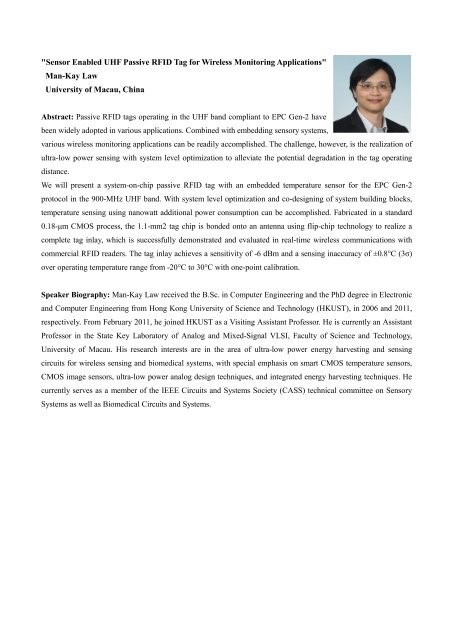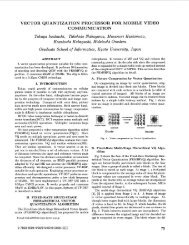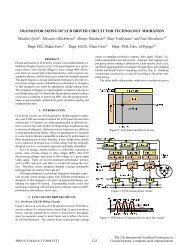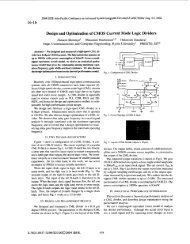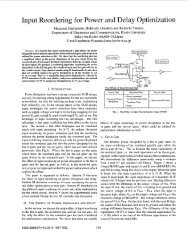RF Channel Filtering: a Revival of N-Path Filters in Nanometer CMOS?
RF Channel Filtering: a Revival of N-Path Filters in Nanometer CMOS?
RF Channel Filtering: a Revival of N-Path Filters in Nanometer CMOS?
Create successful ePaper yourself
Turn your PDF publications into a flip-book with our unique Google optimized e-Paper software.
"Sensor Enabled UHF Passive <strong>RF</strong>ID Tag for Wireless Monitor<strong>in</strong>g Applications"Man-Kay LawUniversity <strong>of</strong> Macau, Ch<strong>in</strong>aAbstract: Passive <strong>RF</strong>ID tags operat<strong>in</strong>g <strong>in</strong> the UHF band compliant to EPC Gen-2 havebeen widely adopted <strong>in</strong> various applications. Comb<strong>in</strong>ed with embedd<strong>in</strong>g sensory systems,various wireless monitor<strong>in</strong>g applications can be readily accomplished. The challenge, however, is the realization <strong>of</strong>ultra-low power sens<strong>in</strong>g with system level optimization to alleviate the potential degradation <strong>in</strong> the tag operat<strong>in</strong>gdistance.We will present a system-on-chip passive <strong>RF</strong>ID tag with an embedded temperature sensor for the EPC Gen-2protocol <strong>in</strong> the 900-MHz UHF band. With system level optimization and co-design<strong>in</strong>g <strong>of</strong> system build<strong>in</strong>g blocks,temperature sens<strong>in</strong>g us<strong>in</strong>g nanowatt additional power consumption can be accomplished. Fabricated <strong>in</strong> a standard0.18-µm <strong>CMOS</strong> process, the 1.1-mm2 tag chip is bonded onto an antenna us<strong>in</strong>g flip-chip technology to realize acomplete tag <strong>in</strong>lay, which is successfully demonstrated and evaluated <strong>in</strong> real-time wireless communications withcommercial <strong>RF</strong>ID readers. The tag <strong>in</strong>lay achieves a sensitivity <strong>of</strong> -6 dBm and a sens<strong>in</strong>g <strong>in</strong>accuracy <strong>of</strong> ±0.8°C (3σ)over operat<strong>in</strong>g temperature range from -20°C to 30°C with one-po<strong>in</strong>t calibration.Speaker Biography: Man-Kay Law received the B.Sc. <strong>in</strong> Computer Eng<strong>in</strong>eer<strong>in</strong>g and the PhD degree <strong>in</strong> Electronicand Computer Eng<strong>in</strong>eer<strong>in</strong>g from Hong Kong University <strong>of</strong> Science and Technology (HKUST), <strong>in</strong> 2006 and 2011,respectively. From February 2011, he jo<strong>in</strong>ed HKUST as a Visit<strong>in</strong>g Assistant Pr<strong>of</strong>essor. He is currently an AssistantPr<strong>of</strong>essor <strong>in</strong> the State Key Laboratory <strong>of</strong> Analog and Mixed-Signal VLSI, Faculty <strong>of</strong> Science and Technology,University <strong>of</strong> Macau. His research <strong>in</strong>terests are <strong>in</strong> the area <strong>of</strong> ultra-low power energy harvest<strong>in</strong>g and sens<strong>in</strong>gcircuits for wireless sens<strong>in</strong>g and biomedical systems, with special emphasis on smart <strong>CMOS</strong> temperature sensors,<strong>CMOS</strong> image sensors, ultra-low power analog design techniques, and <strong>in</strong>tegrated energy harvest<strong>in</strong>g techniques. Hecurrently serves as a member <strong>of</strong> the IEEE Circuits and Systems Society (CASS) technical committee on SensorySystems as well as Biomedical Circuits and Systems.


